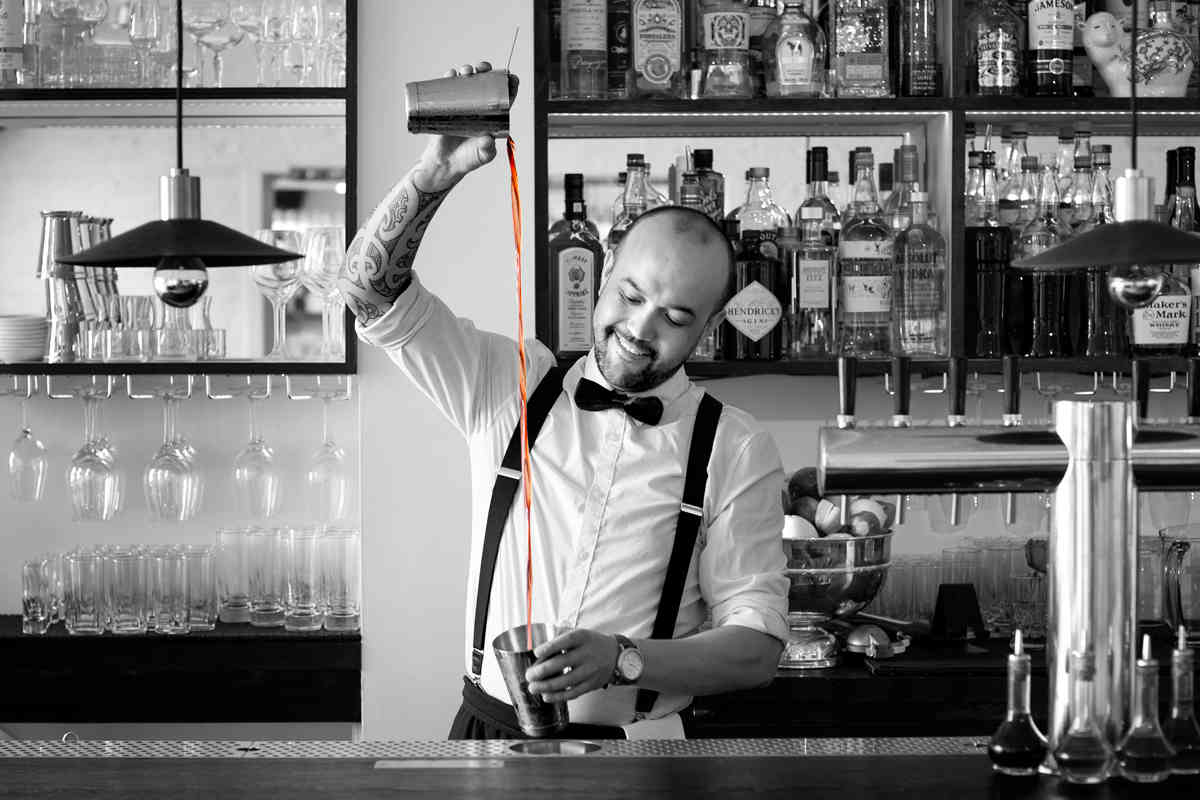We had the chance to speak with Dante Creative Director Naren Young on the eve of the New York City bar’s new Martini Hour menu launch. The Martini Hour is the latest initiative from the historic bar, which currently occupies the #9 position on the World’s 50 Best Bars List and has earned wide-ranging acclaim for its Negroni Sessions menu. We picked Young’s brain on “owning” the Negroni, the state of the Martini, and how he makes his at home.
This interview has been condensed and edited for clarity.
How did end you up at Dante?
All of us have been lifelong hospitality people, starting in Australia. I started when I was about 14, and we all worked our way up through the indie bar scene. I moved to New York about 13 years ago. Linden [Pride] and Natalie [Hudson], my partners, have been over here eight or nine years. We got wind of this old, historic café that was on the verge of closing, and we were given the opportunity to resurrect it and put our own stamp on it while still remaining true to what Dante always was, which was a locals’ café.

Inside Caffe Dante. Credit: Dante.
How did the Negroni emerge as a focus at Dante?
It’s a drink that we all personally love that, four years ago, wasn’t really part of the mainstream, popular culture like it is today. It was quite polarizing, only drunk by bartenders, cocktail enthusiasts, writers, and maybe some old Italian dudes. We wanted to take something that was a little bit under the radar, and shine a light on the drink. That’s one side of it.
Another was creating our version of a Happy Hour. How do we make our own version that fits with what our concept is, what our ethos is, what the background of Dante was, and do it in a way that’s more thoughtful and elegant than what was going on around town? Which was cheap, nasty hooch, 3-for-1 shots, and shitty Martinis that were really about drinking as much as you can as quickly as you can. That’s the opposite of what Dante’s about. So we used that as a basis for our own version, which we loosely referred to as an “Aperitivo Hour,” because Happy Hour isn’t really a term we’re fond of.
Are you now looking to change perceptions of the Martini and the “Martini Hour?”
Part of our programming since the beginning has been to take one drink and really dive deep into it… exploring the opportunities of its history and its chronology and where that fits into our bar program. And hopefully along the way maybe people will be educated a little bit on what that drink means and where it comes from.
We wanted to tell a story with the Negroni first. A couple of years ago, we launched something called the “Summer of Spritz.” The next chapter is exploring the Martini. We want to expose people to this iconic drink in ways that they haven’t seen before, or just in better ways than they’re used to drinking it.
Some bars are doing [the Martini] very well, but I think the majority are doing it quite badly.
I think that the Negroni is definitely one of those drinks that we kind of “own” now. Not to say that other bartenders don’t make great Negronis, but when people think of Negronis they definitely think of Dante, and that’s on a national level. The spritz is something that we’ve hopefully done the same with, and the Martini is next on my radar.

Martini service at Dante. Credit: Dante.
What do you think is the current state of the Martini?
Some bars are doing it very well, but I think the majority are doing it quite badly.
It’s a drink made with such a degree of nonchalance that people, especially bartenders, just roll their eyes and say, “Of course I know how to make a Martini.”
But I don’t know if they deeply think about the minutiae of what makes a great Martini. Whether it’s a frozen glass, the perfect garnish, the right mood, the right lighting, the right music, and the right presentation. All those things come together to make this drink that is at face value quite simple more than the sum of its parts.
Outside of the drink itself, how will Dante try to do it right in terms of service and atmosphere?
I think the tableside Martini service is something that’s unique for the city. There are some bars that are pouring pre-diluted, frozen Martinis from bottles; we certainly aren’t the first. But I think our delivery is going to be the most unique. We’ve got these beautiful, handcrafted labels that have been made by a local artist. We present the Martini like a wine at the table. We’ll present the bottle to you, and then pour your Martini and walk off.
So, there’s definitely this whole ritual that goes along with it, more than just putting a few ingredients in a mixing glass, stirring them and, voila, there’s your Martini! There’s a lot of thought that goes into every little step that makes this more of an experience as opposed to just a drink transaction.

Tableside Martinis at Dante. Credit: Dante.
What common thread has to run through the drinks on the menu for you to consider them part of the Martini family?
One of our main philosophies is that no matter what we do to a classic drink, it should show the same DNA. Even if one of our Martinis has honey, kombu, and Talisker whisky in it, it still looks and tastes like a Martini when you get it. All the Martinis have their place, and they stick to what the flavor profile of a Martini should be, which is cold, bracing, and strong. Some just have a bit more complexity than others.
How do you make Martinis at home?
I make mine 50/50. I generally make them with Ford’s Gin or Plymouth Gin. They’re nice, soft Martini gins. Then Noilly Prat dry vermouth, maybe a little bit of orange bitters, stirred until it’s really cold, and then strained into a frozen glass with a lemon twist, maybe an olive, and I’m happy.



